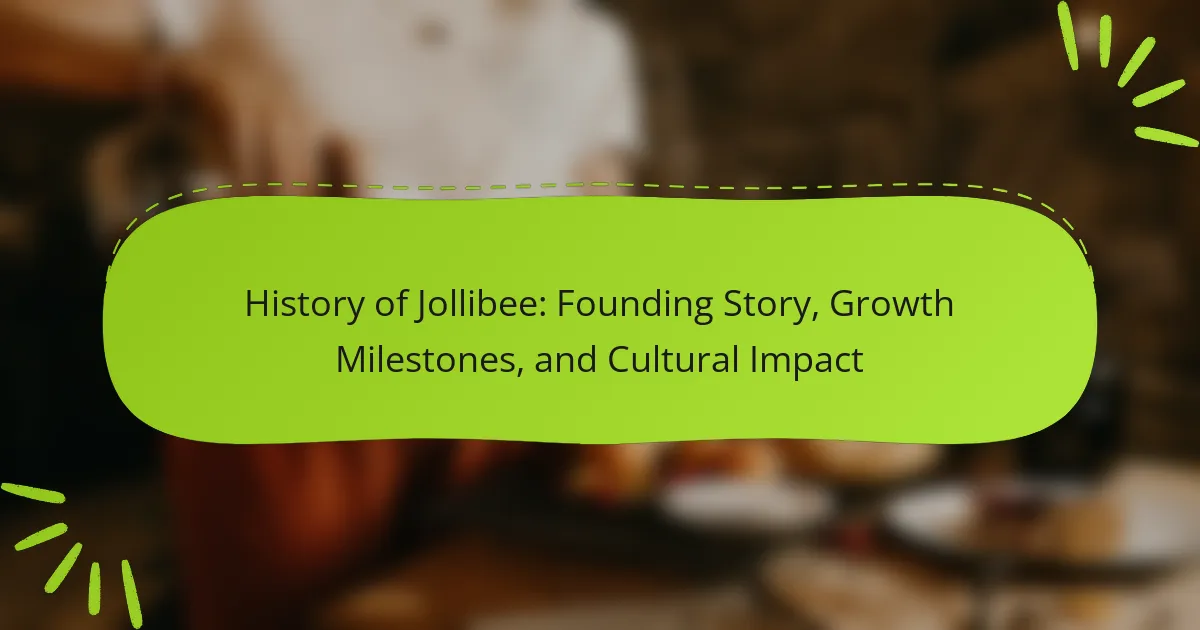Jollibee is a prominent fast-food chain in the Philippines, founded by Tony Tan Caktiong in 1978. Originally starting as an ice cream parlor, Jollibee quickly evolved to meet customer demand by offering hot meals, including burgers and spaghetti. The brand gained rapid popularity, becoming the leading fast-food chain in the Philippines by 1987 and expanding internationally in 1993. Jollibee’s menu features unique Filipino flavors, such as Jolly Spaghetti and Chickenjoy, which resonate with local tastes. The company has also made significant contributions to Filipino society through job creation and social initiatives, reinforcing its status as a symbol of national pride and cultural identity.

What is the founding story of Jollibee?
Jollibee was founded by Tony Tan Caktiong in 1978. Initially, it started as an ice cream parlor in Quezon City, Philippines. The concept evolved to include hot meals after customer demand increased. The first Jollibee store opened on January 28, 1978. It offered burgers, spaghetti, and other Filipino favorites. The brand quickly gained popularity among locals. By 1981, Jollibee had expanded to multiple locations. It became a symbol of Filipino fast food culture and success.
Who founded Jollibee and what inspired its creation?
Jollibee was founded by Tony Tan Caktiong in 1978. The inspiration for its creation came from Tony’s desire to offer delicious food and a fun dining experience. Initially, he opened an ice cream parlor. Customers requested hot meals, prompting him to expand the menu. This led to the introduction of popular Filipino dishes. The unique blend of Western fast food and local flavors set Jollibee apart. Today, it is a symbol of Filipino culture and pride.
What were the initial offerings of Jollibee?
Jollibee’s initial offerings included burgers, spaghetti, and chicken. The brand started as an ice cream parlor in 1978. Soon after, it expanded its menu to include hot meals. The first hot meal offerings were burgers and spaghetti. Jollibee’s signature Chickenjoy was introduced later. These initial offerings helped establish the brand’s identity. Jollibee quickly gained popularity in the Philippines. Its unique menu combined Western fast food with local flavors.
How did the brand evolve from an ice cream parlor to a fast-food chain?
Jollibee evolved from an ice cream parlor to a fast-food chain by diversifying its menu and adapting to customer preferences. Initially, Jollibee started as an ice cream parlor in 1978, offering various cold treats. The founder, Tony Tan Caktiong, recognized the growing demand for hot meals. In response, he introduced a selection of Filipino dishes such as spaghetti and burgers. This shift was influenced by the success of competitors in the fast-food market. By 1981, Jollibee officially transitioned into a fast-food chain. The brand’s unique offerings and local flavors appealed to Filipino consumers. Today, Jollibee is a leading fast-food chain in the Philippines with international locations.
What challenges did Jollibee face during its early years?
Jollibee faced several challenges during its early years. Initially, it struggled with competition from established fast-food brands. These competitors included global giants like McDonald’s, which had a strong foothold in the market. Additionally, Jollibee had to overcome operational difficulties related to supply chain management. Maintaining consistent quality and service was a significant hurdle.
Financial constraints also posed a challenge. The company had limited resources for marketing and expansion. This made it difficult to reach a broader audience. Furthermore, Jollibee encountered cultural resistance. Some consumers were initially hesitant to embrace a local fast-food brand over international options. Despite these challenges, Jollibee adapted its menu to cater to local tastes, which ultimately contributed to its success.
How did Jollibee overcome financial difficulties?
Jollibee overcame financial difficulties by restructuring its operations and focusing on core strengths. The company streamlined its menu to reduce costs and improve efficiency. It also invested in marketing to strengthen brand recognition. Jollibee expanded its presence in international markets, increasing revenue streams. Strategic partnerships and acquisitions helped diversify its offerings. In 2020, Jollibee implemented cost-cutting measures amid the pandemic. These actions collectively restored profitability and strengthened its market position.
What role did customer feedback play in shaping the menu?
Customer feedback was crucial in shaping Jollibee’s menu. It guided the introduction of new items and the refinement of existing offerings. Jollibee actively solicited input from customers through surveys and taste tests. This approach allowed the brand to identify popular flavors and preferences. For instance, the success of the Chickenjoy was influenced by customer demand for fried chicken. Feedback also led to the addition of spaghetti to cater to local tastes. By responding to customer preferences, Jollibee enhanced its menu and strengthened brand loyalty. This strategy has contributed to its growth and cultural relevance in the Philippines and beyond.

What are the key growth milestones in Jollibee’s history?
Jollibee’s key growth milestones include its founding in 1978 as an ice cream parlor. In 1981, it transitioned to serving hot meals, marking its entry into the fast-food market. By 1987, Jollibee became the leading fast-food chain in the Philippines. In 1993, it opened its first international store in the United States. The company went public in 1993, raising significant capital for expansion. By 2004, Jollibee had over 500 stores nationwide. In 2018, it acquired the American fast-food chain Smashburger. As of 2023, Jollibee operates over 1,400 stores globally, solidifying its position as a major player in the fast-food industry.
When did Jollibee first expand beyond its original location?
Jollibee first expanded beyond its original location in 1981. This expansion marked the opening of its first store outside of Manila, specifically in Quezon City. This move was part of Jollibee’s strategy to grow its presence in the Philippines. The company aimed to reach more customers and enhance brand visibility. This expansion laid the groundwork for future growth across the nation. Jollibee has since become a dominant fast-food chain in the Philippines.
What strategies did Jollibee use to open new branches?
Jollibee used multiple strategies to open new branches. They focused on market research to identify high-potential locations. This approach ensured that each new branch met local demand. Jollibee also employed a franchise model to accelerate expansion. By franchising, they leveraged local entrepreneurs’ knowledge and investment. Moreover, they adapted their menu to cater to regional tastes. This localization strategy helped attract diverse customer bases. Jollibee’s aggressive marketing campaigns further supported brand visibility. They utilized promotions and community engagement to build a loyal customer following.
How did Jollibee’s menu diversify over the years?
Jollibee’s menu diversified significantly over the years by introducing a variety of food items beyond its original offerings. Initially, Jollibee focused on burgers, spaghetti, and chicken. As the brand grew, it expanded its menu to include rice meals, breakfast items, and desserts. The introduction of localized flavors and dishes catered to regional tastes. For example, Jollibee added the Jolly Spaghetti, which features a sweet sauce popular in the Philippines. Furthermore, collaborations and limited-time offerings have introduced items like burgers with unique toppings. The menu now includes options for different dietary preferences, such as vegetarian meals. This diversification has contributed to Jollibee’s appeal across various demographics and markets.
What significant acquisitions has Jollibee made?
Jollibee has made several significant acquisitions to expand its global presence. In 2018, Jollibee acquired the American fast-food chain Smashburger for approximately $335 million. This acquisition aimed to diversify its portfolio and enter the U.S. market more aggressively. In 2019, Jollibee purchased a 50% stake in the coffee chain Coffee Bean & Tea Leaf for about $350 million. This move was part of Jollibee’s strategy to strengthen its presence in the coffee segment. Additionally, Jollibee acquired the British chain Pret A Manger in 2021, further expanding its international footprint. These acquisitions reflect Jollibee’s commitment to growth and diversification in the competitive food industry.
How have mergers and acquisitions influenced Jollibee’s market presence?
Mergers and acquisitions have significantly enhanced Jollibee’s market presence. The acquisition of businesses like Chowking and Greenwich expanded its brand portfolio. This strategy enabled Jollibee to penetrate new market segments and diversify its offerings. In 2018, Jollibee acquired the American fast-food chain Smashburger, increasing its footprint in the U.S. market. This move allowed Jollibee to reach a broader customer base. Furthermore, Jollibee’s acquisition of Coffee Bean & Tea Leaf in 2019 strengthened its position in the coffee and beverage sector. Overall, these strategic mergers and acquisitions have solidified Jollibee’s status as a global fast-food leader.
What impact did acquiring other brands have on Jollibee’s growth?
Acquiring other brands significantly accelerated Jollibee’s growth. This strategy allowed Jollibee to diversify its menu and expand its market reach. Notable acquisitions include the purchase of Mang Inasal in 2010, which increased its presence in the grilled chicken segment. Additionally, acquiring Chowking in 2000 broadened Jollibee’s offerings to include Chinese cuisine. These acquisitions contributed to increased sales and brand recognition. In 2018, Jollibee acquired Coffee Bean & Tea Leaf, further enhancing its footprint in the beverage sector. Overall, these strategic moves have positioned Jollibee as a formidable player in the global fast-food market.

How has Jollibee impacted Filipino culture and society?
Jollibee has significantly impacted Filipino culture and society by becoming a symbol of national pride. It represents the fusion of Western fast food with Filipino flavors, showcasing local culinary preferences. Jollibee’s menu includes items like the Jolly Spaghetti and Chickenjoy, which resonate with Filipino tastes. The brand has created a sense of community through family-oriented marketing and celebrations. Jollibee’s presence has contributed to job creation, employing thousands of Filipinos across the nation. The company also engages in various social initiatives, supporting education and disaster relief efforts. This involvement enhances its reputation as a socially responsible entity. Jollibee’s success story serves as an inspiration for local entrepreneurs, promoting the idea of homegrown success. Overall, Jollibee’s influence extends beyond food, shaping cultural identity and fostering national pride in the Philippines.
Why is Jollibee considered a cultural icon in the Philippines?
Jollibee is considered a cultural icon in the Philippines due to its deep-rooted connection with Filipino identity. The brand represents national pride and resilience, often symbolizing the success of local entrepreneurship. Jollibee’s mascot, a joyful bee, resonates with Filipino values of happiness and family. The company has successfully integrated local flavors into its menu, appealing to Filipino tastes. Jollibee’s marketing campaigns often celebrate Filipino culture and traditions, further solidifying its cultural relevance. The chain’s widespread presence across the country makes it a familiar and beloved part of everyday life. According to a 2020 survey, Jollibee was ranked as the most popular fast-food brand in the Philippines, reflecting its status in the hearts of Filipinos.
What role does Jollibee play in Filipino celebrations and traditions?
Jollibee serves as a central figure in Filipino celebrations and traditions. It is commonly featured in birthday parties, family gatherings, and festive events. The brand symbolizes joy and togetherness for many Filipinos. Its mascot, Jollibee, is often a highlight for children during celebrations. Jollibee’s menu, including its signature chickenjoy, is a favorite among guests. The restaurant chain has become synonymous with special occasions in the Philippines. This association has led to Jollibee being a staple in Filipino culture. Its presence during holidays and milestones reinforces its role in community bonding.
How does Jollibee contribute to local communities?
Jollibee contributes to local communities through various initiatives and programs. The company engages in community development projects that focus on education, health, and nutrition. Jollibee’s “Busog, Lusog, Timplang Pambata” program provides nutritious meals to underprivileged children. This initiative aims to combat malnutrition and promote healthy eating habits. Additionally, Jollibee supports local farmers by sourcing ingredients from them, which boosts the local economy. The company also participates in disaster relief efforts, providing food and support during emergencies. Through these actions, Jollibee reinforces its commitment to social responsibility and community welfare.
What is Jollibee’s approach to global expansion?
Jollibee’s approach to global expansion focuses on strategic market entry and localized menu offerings. The company targets countries with significant Filipino populations first. This strategy helps establish brand familiarity and customer loyalty. Jollibee adapts its menu to cater to local tastes, incorporating regional flavors. For instance, in the United States, Jollibee offers spaghetti with a sweet sauce, appealing to American palates. The brand also emphasizes aggressive marketing and community engagement in new markets. Jollibee has successfully opened over 1,500 stores globally, showcasing its effective expansion strategy.
How does Jollibee adapt its menu for different international markets?
Jollibee adapts its menu for different international markets by incorporating local flavors and preferences. This strategy helps the brand resonate with diverse customer bases. For instance, in the United States, Jollibee offers spaghetti with a sweeter sauce, reflecting American tastes. In the Middle East, the menu includes items like Chickenjoy with spicy sauces to cater to regional palates. Jollibee also introduces unique offerings, such as the Jolly Hotdog in select markets. The company conducts market research to understand local food preferences. This approach has contributed to Jollibee’s successful expansion globally.
What challenges does Jollibee face in maintaining its brand identity abroad?
Jollibee faces challenges in maintaining its brand identity abroad due to cultural differences. Each market has unique tastes and preferences that may not align with Jollibee’s traditional offerings. Adapting the menu while retaining core brand elements can dilute brand identity. Competition from local fast-food chains also poses a threat. These competitors often have established customer loyalty and understand local consumer behavior better. Additionally, marketing strategies must be tailored to resonate with diverse audiences. Misalignment in messaging can lead to brand confusion. Jollibee must navigate these complexities to preserve its identity while appealing to international customers.
What lessons can be learned from Jollibee’s journey?
Jollibee’s journey teaches several important lessons. First, adaptability is crucial for success. Jollibee started as an ice cream parlor but shifted to hot meals based on customer feedback. Second, understanding local culture enhances brand connection. Jollibee incorporates Filipino flavors and values in its menu and marketing. Third, strong branding builds loyalty. The cheerful mascot and catchy slogans resonate with consumers. Fourth, strategic expansion is vital. Jollibee successfully entered international markets, growing from a local brand to a global presence. Lastly, innovation keeps a brand relevant. Jollibee regularly updates its menu to meet changing consumer preferences. These lessons highlight the importance of flexibility, cultural relevance, branding, strategic growth, and innovation in business success.
How can other businesses apply Jollibee’s strategies for success?
Other businesses can apply Jollibee’s strategies for success by focusing on localization, strong branding, and customer experience. Jollibee tailors its menu to local tastes, which enhances customer satisfaction and loyalty. For example, it offers unique products like the Jolly Spaghetti in the Philippines, appealing to local preferences.
Additionally, Jollibee’s branding emphasizes family values and happiness, creating an emotional connection with customers. This strategy fosters brand loyalty and repeat business. The company also invests in employee training to ensure high-quality customer service.
Research shows that companies with strong customer service see increased revenue and customer retention. By adopting these strategies, businesses can improve their market presence and customer engagement.
What best practices can be derived from Jollibee’s cultural impact?
Jollibee’s cultural impact highlights several best practices for businesses. Firstly, embracing local culture fosters strong customer loyalty. Jollibee integrates Filipino values and traditions into its branding and menu. This connection resonates deeply with consumers, reinforcing brand identity. Secondly, community involvement enhances brand perception. Jollibee actively participates in charitable initiatives, strengthening its image as a socially responsible entity. Thirdly, adapting to market demands is crucial. Jollibee’s menu evolves based on customer preferences, demonstrating responsiveness. Finally, storytelling in marketing creates emotional connections. Jollibee’s advertisements often feature relatable narratives, engaging audiences effectively. These practices illustrate how cultural alignment, community engagement, adaptability, and storytelling drive business success.
The main entity of the article is Jollibee, a fast-food chain founded by Tony Tan Caktiong in 1978 in the Philippines. The article outlines Jollibee’s evolution from an ice cream parlor to a leading fast-food chain, highlighting key milestones such as its menu diversification, expansion strategies, and significant acquisitions. It also examines the brand’s cultural impact in the Philippines, emphasizing its role in community engagement and national pride. Additionally, the article discusses the challenges Jollibee faced during its growth and the lessons that can be learned from its journey.
